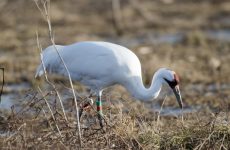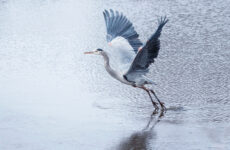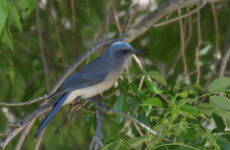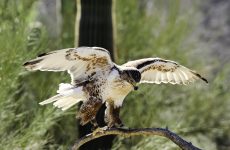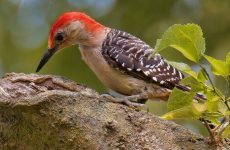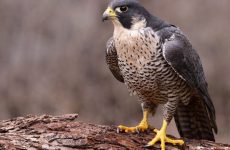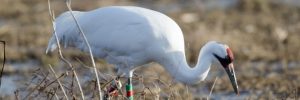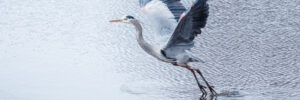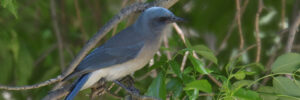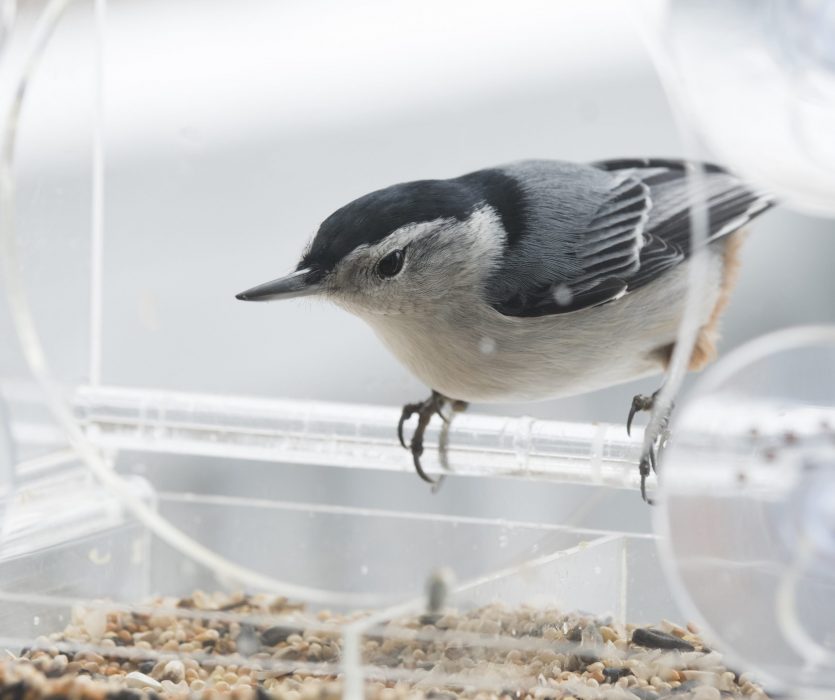
Do you want to know what birds of Wisconsin are visiting your backyard in winter? Watching the birds outside in the cold flocking to your feeders while you sit by the window with a hot drink, is one of the joys of winter.
Get to know all the common winter birds in Wisconsin and how to attract more of them to your yard to bring you joy in winter every day.
They are the birds that appear most frequently on Wisconsin bird checklists on ebird in December and January.
Top 20 Backyard Winter Birds of Wisconsin:
- Black-capped Chickadee (53.5%)
- American Crow (44.4%)
- Dark-eyed Junco (41.6%)
- Downy Woodpecker (40.1%)
- White-breasted Nuthatch (37.7%)
- Northern Cardinal (35.7%)
- American Goldfinch (33.3%)
- Blue Jay (30.4%)
- Mourning Dove (30.1%)
- Red-bellied Woodpecker (27.4%)
- House Sparrow (26.3%)
- Hairy Woodpecker (24.2%)
- House Finch (21%)
- European Starling (17)%
- American Tree Sparrow (16.5%)
- Red-breasted Nuthatch (12.6%)
- Rock Pigeon (12.2%)
- Pine Siskin (8.7%)
- Tufted Titmouse (8%)
- American Robin (6.8%)
Compared to summer, notable differences of winter birds in Wisconsin are Downy and Red-bellied Woodpeckers are more commonly seen, especially at suet feeders.
House Wrens, Gray Catbirds, Red-eyed Vireo, Common Yellowthroats, Indigo Buntings, and Common Grackles have migrated south in the fall.
American Tree Sparrows, Red-breasted Nuthatches, and Pine Siskins migrate in from breeding grounds further north.
Find out more about these winter birds in Wisconsin that visit feeders and backyards, see photos, and find out how you can attract more of these winter birds to your backyard.
Get Free Printables, with pictures of the backyard birds in Wisconsin throughout the year, to create your own tally:
This site is reader-supported and as an Amazon Associate, I earn a commission if you purchase a product I recommend at no extra cost to you.
20 Most Common Backyard Winter Birds in Wisconsin
1. Black-capped Chickadee
Black-capped Chickadees are cute birds with big round heads and tiny bodies. These birds will happily feed at backyard feeders and will investigate everything including you!
Black-capped Chickadees have black-caps and beaks, white cheeks, and are gray on the back, wings, and tail. They can be found in forests, open woods, parks. Black-capped Chickadees eat seeds, berries and insects, spiders, and suet.
Chickadees will grab a seed and go to a perch to open and eat them. Stopping bigger bully birds or squirrels from plundering your feeders and stopping flocks of chickadees brightening up your day is easily solved with the Woodlink Caged feeder that is super easy to clean. In winter this Upside Down Suet Feeder helps the little guys get some winter fuel.
To attract more Black-capped Chickadees to your backyard try suet, sunflower seeds, and peanuts or peanut butter. They will even feed from your hand and are often one of the first birds to discover new feeders. They will also use nest boxes, especially if you fill them with wood shavings.
Black-capped Chickadees are the most commonly spotted winter bird in Wisconsin and they are spotted in 53% of recorded checklists on ebird.org.
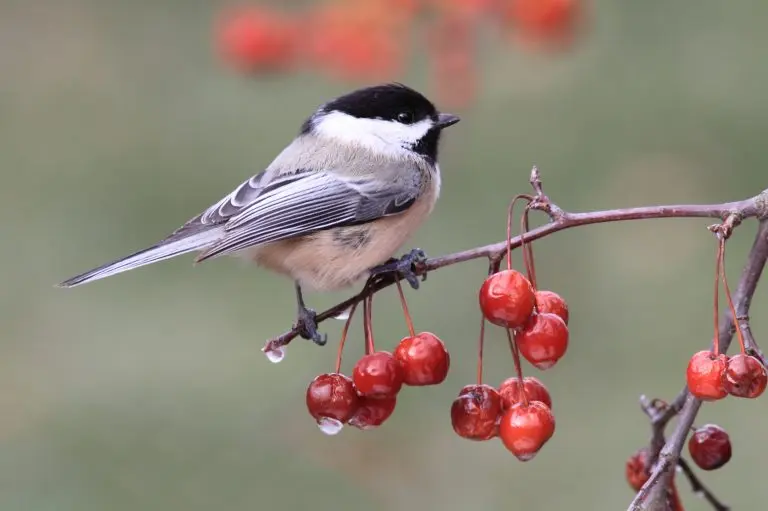
2. American Crow
American crows are large all-black birds that make a hoarse, cawing sound. They are common birds that can be found in most habitats including treetops, woods, fields, beaches, or towns.
They eat most things and usually feed on the ground eating earthworms, insects, seeds, and fruit. They also eat fish, young turtles, mussels, and clams and will even eat eggs and nestlings of many species of birds.
American Crows gather in large numbers of up to two million crows in winter to sleep in communal roosts.
You can attract more American Crows to your backyard by scattering peanuts but can become a nuisance as attracted by garbage or pet food if left out.
Crows are very intelligent birds, and whether you love them or not they are very common birds in winter in Wisconsin.
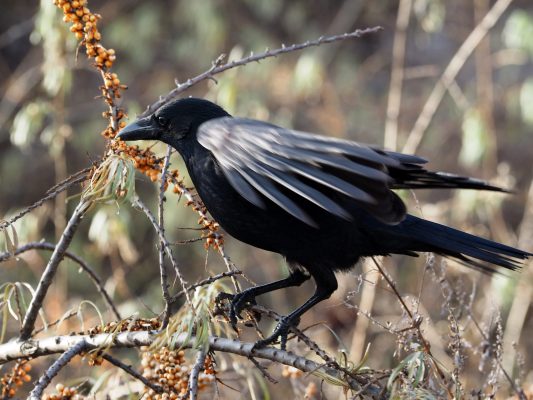
3. Dark-eyed Junco
Dark-eyed Juncos are sparrows that are different colors depending on the state. They are generally slate-colored in the east and black, white, and brown in the west.
They can be found in open and partially wooded areas often on the ground and are common across the continent. Some remain resident all year in the west and in the Appalachian Mountains. Those that breed in Canada and Alaska migrate south in winter to much of the United States.
Juncos prefer to feed near the ground and it’s best to keep ground feeders away from shrubs where cats and predators can hide so this covered feeder is great for keeping out the elements. A budget-friendly alternative that allows rain to drain out is this simple platform feeder.
You can attract more Dark-eyed Juncos to backyard feeders with a variety of seeds such as black oil sunflower seeds, nyjer, cracked corn, millet, and peanuts. Platform feeders or scattered on the ground are best.
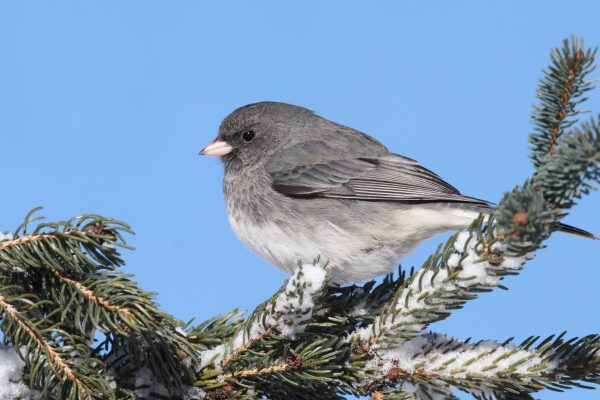
4. Downy Woodpecker
Downy Woodpeckers are small birds that are common at backyard feeders. They are often mixed in with other birds such as chickadees and nuthatches. Woodpeckers are often seen at feeders in winter in Wisconsin.
They have black and white coloring with a red patch at the back of their heads. They look similar to the Hairy Woodpecker but smaller.
Downy woodpeckers can be found in woodlots, along streams, city parks, and backyards and eat mainly insects beetle larvae, but also berries, acorns, and grains.
An upside-down suet feeder is excellent for smaller woodpeckers such as Downy Woodpeckers as they offer protection from the rain and help stop bully birds. A bulk pack of suet cakes is a more economical way of buying them.
Also, black oil sunflower seeds attract more Downy Woodpeckers to your yard and if you combine them with suet in a great combination suet and hopper feeder then you get two feeders in one.
To attract more Downy Woodpeckers to your backyard try suet feeders but they will also eat black oil sunflower seeds, millet, and peanuts on platform feeders.
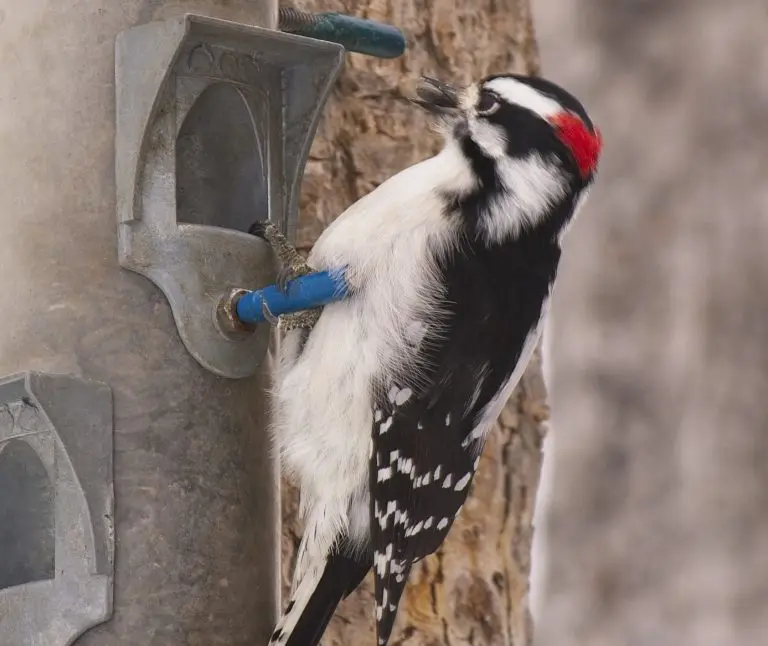
5. White-breasted Nuthatch
White-breasted Nuthatches are active little birds that are gray-blue on the back and white on the face and belly, with a black cap.
They jam large nuts and acorns into tree bark and then whack them with their bills to open or ‘hatch’ them to get the seed out.
Nuthatches love black oil sunflower seeds and this Droll Yankees feeder makes it so easy to clean, stopping food from going moldy and making birds ill.
You can attract more White-breasted Nuthatches to your backyard with sunflower seeds and peanuts on tube feeders or suet feeders.
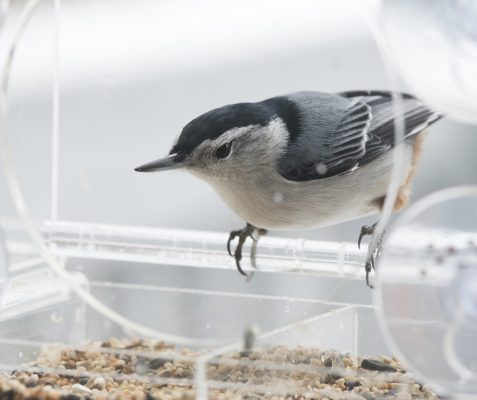
6. Northern Cardinal
The bright red male Northern Cardinal with black around their faces is a great sight, especially against a white winter background. The females are also a little showy with their brown coloring, sharp brown crest, red highlights, and red beaks.
Northern Cardinals will sometimes attack their own reflection during breeding season as they obsessively defend their territories.
Cardinals are heavy birds with quite large beaks so they need a suitable hopper feeder or feeder with a big enough area for them to perch. The Woodlink Absolute feeder is very sturdy and cardinals love this feeder as they have a big enough area to perch without tipping the feeder as with lightweight feeders. This is also squirrel proof which is always a bonus.
You can attract more Northern Cardinals to backyard feeders with sunflower seeds, peanut hearts, millet, and milo. They will feed from large tube feeders, hoppers, platform feeders, or food scattered on the ground.
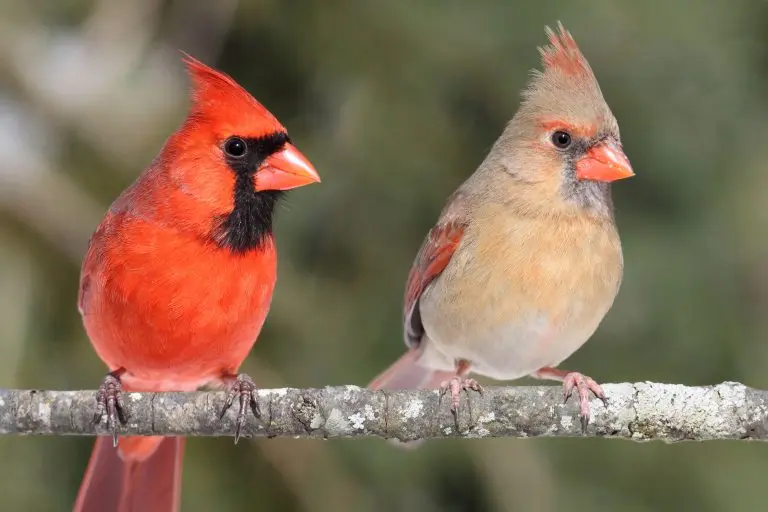
7. American Goldfinch
American Goldfinches are popular birds with the males bright yellow and black coloring in spring. The females are more dull brown as are males in winter.
American Goldfinches breed in far northern states and Canada before migrating to southern states, they remain all year in the rest of the U.S.
They can be found in weedy fields and overgrown areas foraging for sunflower, thistle, and aster plants. They are also common in suburbs, parks, and backyards.
Goldfinches often travel in flocks and to get a swarm of them fly-in is a sight you need to create. This is made possible with this Droll Yankees flocker feeder that has a staggering 20 ports to really get the party going.
To attract more American Goldfinches to your backyard try planting thistles and milkweed. They will visit most bird feeders and prefer sunflower seed and nyjer seed.
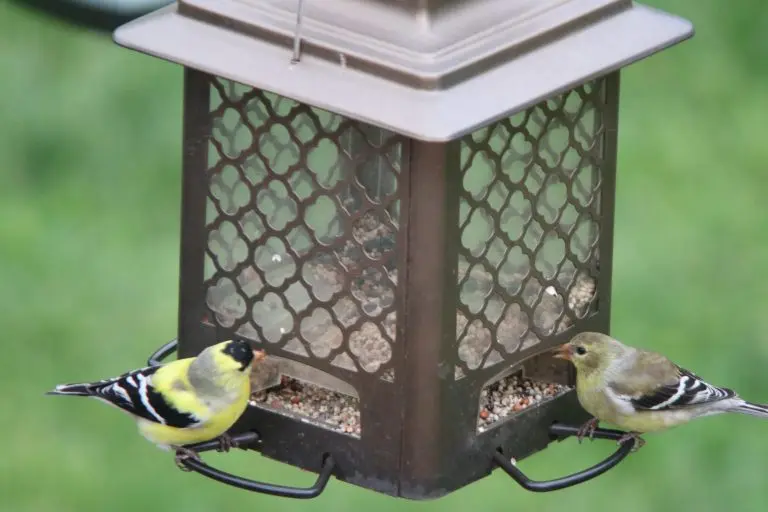
8. Blue Jay
Blue Jays are common large songbirds with a blue upright crest, blue and black backs, and white undersides.
They are noisy birds that travel in family groups eating acorns when available. Mostly resident but may migrate from the far northwest of US and can migrate in large flocks along the Great Lakes and Atlantic coast.
They can be found in forests, but especially near oak as they eat acorns. They can also be found in backyards near feeders. As well as acorns they eat insects, nuts and seeds, and grain. They may also take eggs from nests or take nestlings.
Blue Jays are large birds and prefer to fly in grab a peanut or sunflower seed and take it away to feed. They prefer platform or tray feeders to make it easy to make a quick exit. This Woodlink Audubon Platform Feeder can be either hung, pole mounted or placed on the ground and has a mesh screen on the bottom to allow for rain drainage which is essential to stop feed from going moldy.
To attract more Blue Jays to your backyard try peanuts, sunflower seeds, and suet but they prefer these on tray feeders or hopper feeders on a post. They will also enjoy a birdbath.
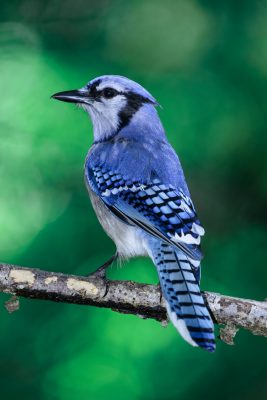
9. Mourning Dove
Mourning Doves are graceful small-headed birds, plump bodies and long tails. They are a soft brown with black spots on the wings.
They can be seen perching on telephone wires and forage for seeds on the ground in grasslands, fields, and backyards. Mourning Doves can be found in open areas or on the edge of woodland. Mourning Doves are common over all of the lower 48 all year but may migrate after breeding from the far north.
Doves prefer to feed near the ground and it’s best to keep ground feeders away from shrubs where cats and predators can hide so this covered feeder is great for keeping out the elements. A budget-friendly alternative that allows rain to drain out is this simple platform feeder.
You can attract more Mourning Doves to your backyard by scattering millet on the ground or on platform feeders. They will also eat black sunflower seeds, nyjer, cracked corn, and peanut hearts.
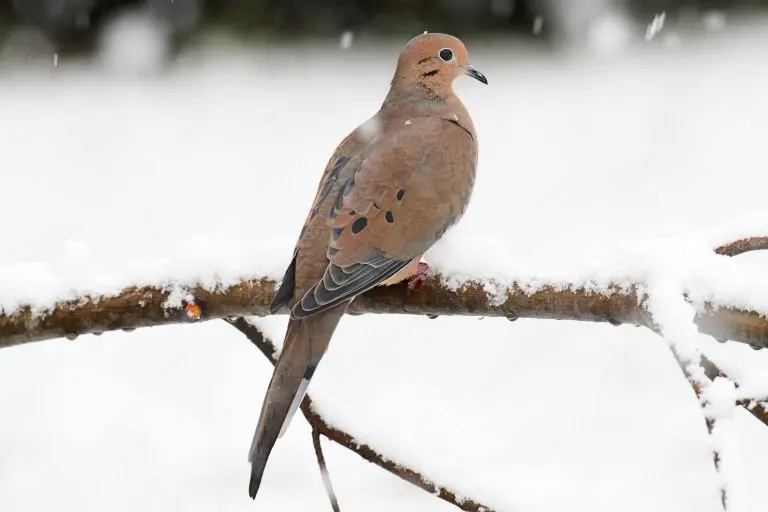
10. Red-bellied Woodpecker
Red-bellied Woodpeckers have a pale red belly that can be difficult to spot, with a red cap and nape and black-and-white stripped back. They are a similar size as a Hairy Woodpecker at around 9 inches.
They make a loud call in spring and summer and are found in woods and forests, especially with deadwood in eastern states. Red-bellied Woodpeckers eat mainly insects and spiders but they will also eat acorns, nuts and pine cones, and some seeds and fruits.
Red-bellied Woodpeckers will come to backyards for suet so try an upside-down suet feeder that can help stop squirrels and bully birds. These suet cakes come in a cheaper bulk pack.
Also, black oil sunflower seeds attract more Red-bellied Woodpeckers to your yard and if you combine them with suet in a great combination suet and hopper feeder then you get two feeders in one.
They can also be seen on hummingbird feeders and will feed on fruit. Planting native berry trees such as hawthorn or mountain-ash.
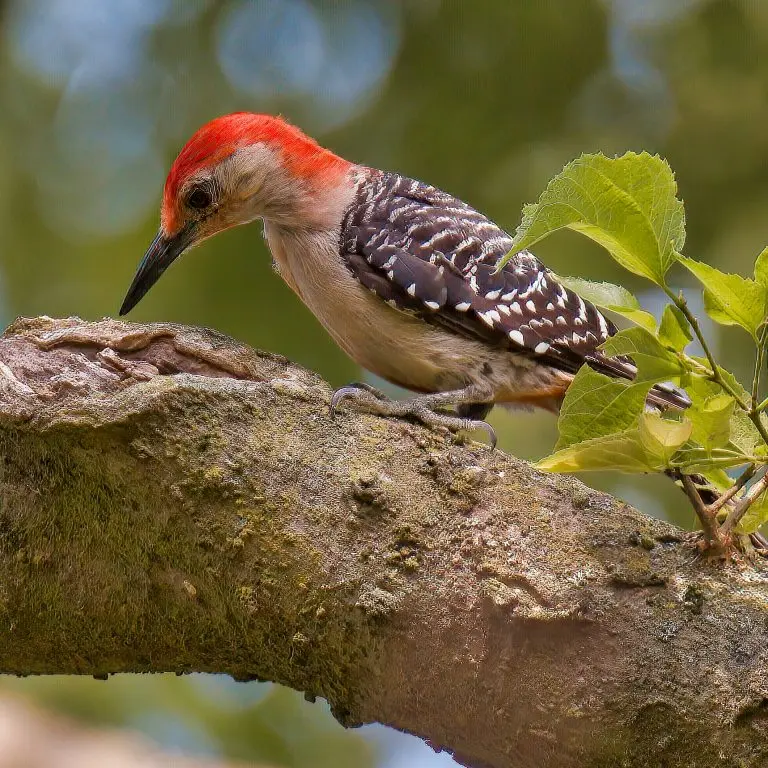
11. House Sparrow
The House Sparrow is another introduced species that has done very well and is now one of the most common birds. They are found near houses and buildings and can be quite tame so will eat out of your hand.
They can be considered a pest as they are non-native but will be found in backyards even if you do not feed them.
Small birds need a feeder that stops bigger ‘bully’ birds such as starlings, grackles, and blackbirds from taking all your bird feed and scaring off the small songbirds. Tube feeders with cages are essential in your feeder set up and the Woodlink Caged feeder is super easy to clean and is a perfect feeder for small birds.
You can attract more House Sparrows to your backyard feeders with most kinds of birdseed, including millet, corn, and sunflower seeds.
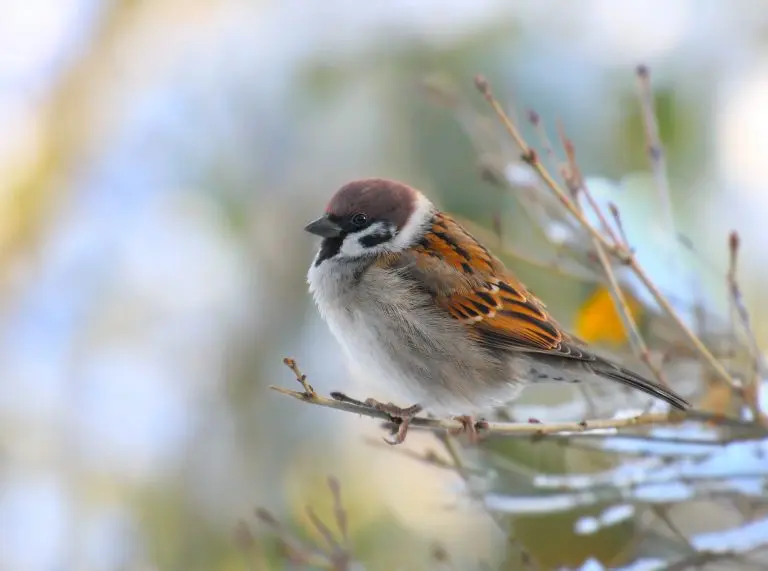
12. Hairy Woodpecker
Hairy Woodpeckers are black and white with a red patch on the back of their heads. They are slightly bigger than their lookalikes the Downy Woodpecker.
They can be found in woods and forests and parks but also at backyard feeders. Hairy woodpeckers are one of three woodpeckers that are common winter birds in Wisconsin.
You can attract more Hairy Woodpeckers to your backyard with suet feeders but also peanut and black oil sunflower seeds on platform feeders.
Hairy Woodpeckers benefit from squirrel-proof suet feeders with a cage to stop larger birds from taking all the turns. A bulk pack of suet cakes is a more economical way of buying them. Also, black oil sunflower seeds attract more Hairy Woodpeckers to your yard and if you combine them with suet in a great combination suet and hopper feeder then you get two feeders in one.
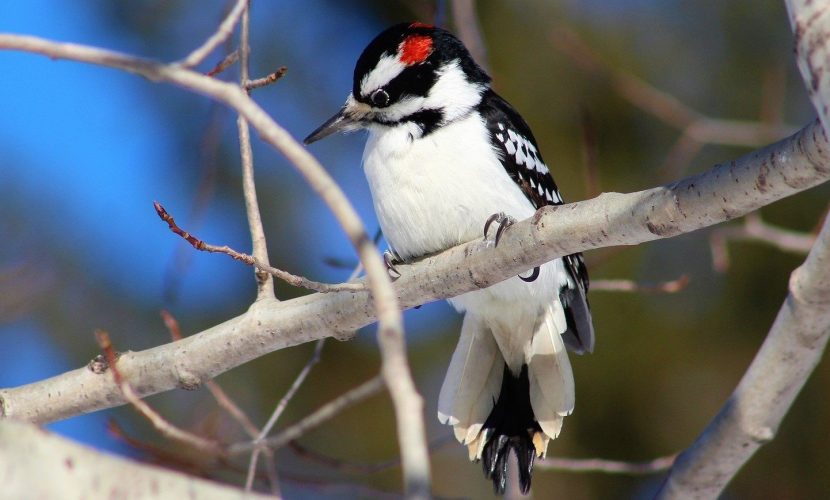
13. House Finch
House Finches have a red head and breast in the males and brown-streaked coloring in the females. Originally only in western states it was introduced to the eastern states and has done very well, even pushing out the Purple Finch.
They can be found in parks, farms, forest edges, and backyard feeders. They can be found in noisy groups that are hard to miss.
Nyjer seeds are a favorite food of finches and this easy clean finch feeder from Droll Yankees ensures your wild birds stay healthy.
You can attract more House Finches to backyard feeders with black oil sunflower seeds or nyjer seeds in tube feeders or platform feeders.
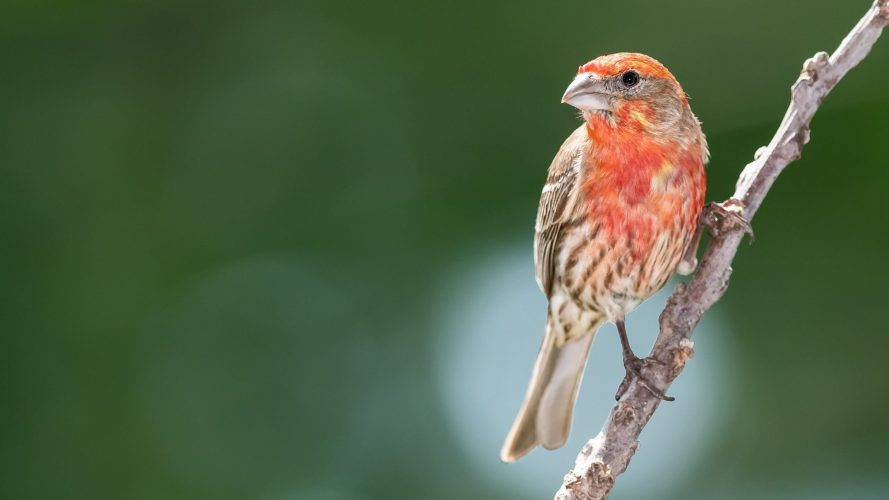
14. European Starling
European Starlings are not native but are now one of the most numerous songbirds. They are stocky black birds with iridescent purple, green, and blue tones.
Considered a pest by some due to their aggressive behavior these birds fly in large noisy flocks and can be seen perched in groups on the top of trees or flying over fields in flocks. To stop European Starlings from dominating your feeders tube feeders with cages are essential in your feeder set up and the Woodlink Caged feeder is super easy to clean and is a perfect feeder for small birds to fly through and leave the starlings out.
You can attract more European Starlings to your backyard feeders with black oil sunflower seeds, suet, cracked corn, and peanuts.
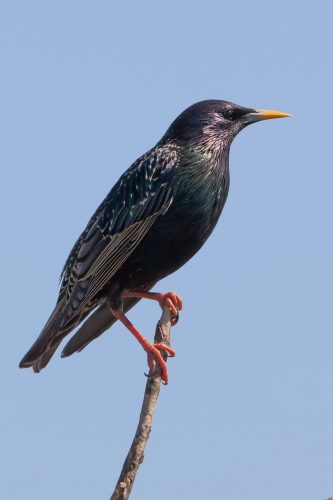
15. American Tree Sparrow
American Tree sparrows can be found in winter after breeding in Canada.
They are long-tailed brown-streaked plump birds with rusty caps, gray faces, and a rusty eyeline. They forage in small flocks in weedy fields and under bird feeders.
Small birds need a feeder that stops bigger ‘bully’ birds such as starlings, grackles, and blackbirds from taking all your bird feed and scaring off the small songbirds. Tube feeders with cages are essential in your feeder set up and the Woodlink Caged feeder is super easy to clean and is a perfect feeder for small birds.
You can attract more American Tree Sparrows to your backyard platform feeders with black oil sunflower seeds, nyjer, cracked corn, and millet. They also feed off the ground under tube feeders foraging for seeds dropped or discarded from above.

16. Red-breasted Nuthatch
Red-breasted Nuthatches remain all year in Northern states and into Canada but may move south in winter if cone crops are poor.
They are blue-gray birds with black and white stripes on the head and a rusty underside.
Red-breasted Nuthatches can be found in coniferous woods foraging for cones and they do visit backyard feeders.
Nuthatches love black oil sunflower seeds and this Droll Yankees feeder makes it so easy to clean, stopping food from going moldy and making birds ill.
You can attract more Red-breasted Nuthatches to your backyard with black oil sunflower seeds, suet feeders, peanuts, and mealworms.
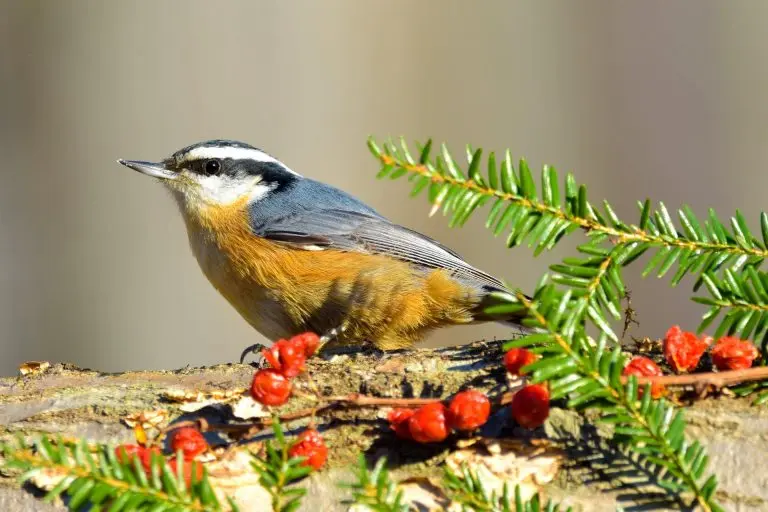
17. Rock Pigeon
Rock Pidgeons are blueish gray with two black bands on the wing and black on the tail tip. They have iridescent throat feathers and orange eyes.
They are common in cities but also visit backyards to find food on the ground but some cities have ordinances against feeding pigeons as they are considered pests.

18. Pine Siskin
Pine Siskins are brown-streaked finches with flashes of yellow on the wing and tail edges. They have small pointed beaks and forked tails.
Pine Siskins breed in Canada in conifer woods and will spend all year in parts of some northern states and the Rockies. They will winter over most of the continent but the timings and extent can vary greatly.
Nyjer seeds are a favorite food of Siskins and this easy clean finch feeder from Droll Yankees will have them turning up every time.
They can be found in flocks foraging for seeds and at backyard feeders for nyjer seeds or millet and hulled sunflower seeds.
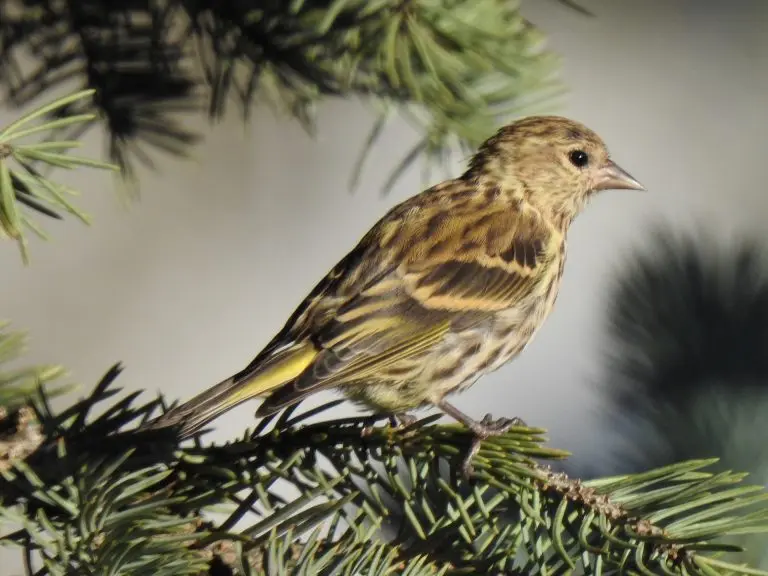
19. Tufted Titmouse
The Tufted Titmouse is gray on the back and white underneath with a cute gray crest and large eyes that often flock with chickadees, nuthatches, and woodpeckers.
They can be assertive over smaller birds and are found in woodlands, parks, and at backyard feeders.
You can attract Tufted Titmice to your backyard feeders with sunflower seeds, suet, and peanuts on tube feeders or suet cages. They will also eat from platform feeders or hopper feeders. This Woodlink Hopper Feeder is not only squirrel-proof but protects the seed from rain and is really sturdy, making it last a long time. Tufted Titmice also prefer suet feeders with tail props to balance their long tails on.
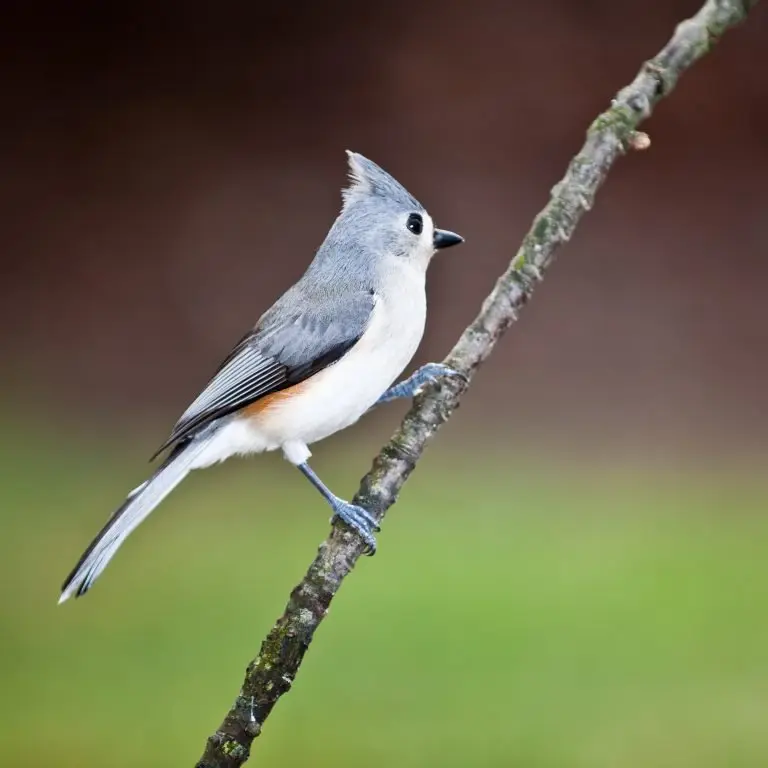
20. American Robin
American Robins are a common sight on lawns eating earthworms. They have black heads and backs with red or orange breasts. They tend to roost in trees in winter so you are more likely to see them in your backyard from spring.
American robins do not regularly visit feeders, although they are common in backyards. Providing a habitat with lots of insects is the best way to encourage them but they sometimes eat sunflower seeds, suet and peanut hearts, fruit, and mealworms on platform feeders on the ground.
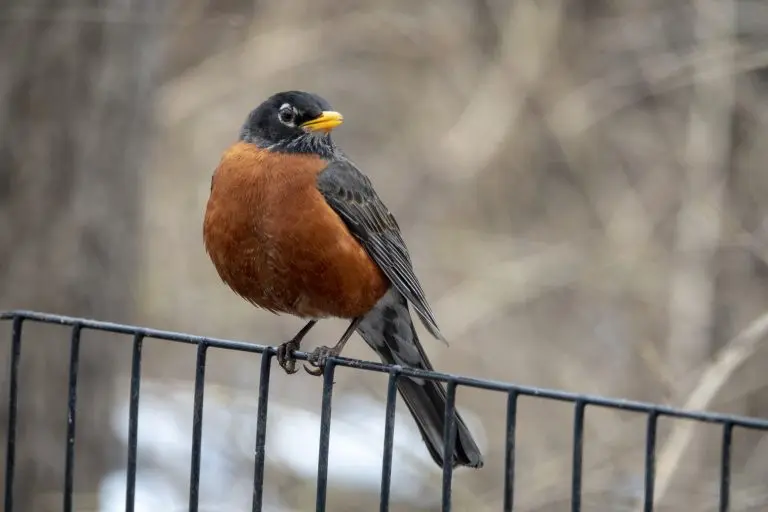
Best Bird Feeders to Attract Birds
A variety of different bird feeders will attract the most species of birds in Wisconsin to your backyard but suet feeders are especially popular in winter
- Tube Feeders can be filled with different types of birdseed and depending on the seed different birds will be attracted. Black oil sunflower seeds attract Goldfinches, Chickadees, Woodpeckers, Nuthatches, and Pine Siskins.
- Ground Feeders or a tray below a Tube Feeder with Black oil sunflowers tube feeders attract Cardinals, Jays, Finches, and Sparrows.
- Platform feeders with Millet or Corn attract small and medium-sized birds such as sparrows, Blackbirds, Towhees, Juncos, Doves, Grackles, and Starlings.
- Peanut feeders attract Woodpeckers, Chickadees, Nuthatches, Titmice, Jays, Juncos, Finches, and Sparrows.
- Suet Feeders are great, especially in winter, for Woodpeckers, Cardinals, Nuthatches, Kinglets, Wrens, and Chickadees.
How to Attract Birds to Your Backyard in Wisconsin
If you would like to attract more birds to your yard in Wisconsin here are some tips:
- Provide bird feeders for different types of birds to get the most species to visit your yard.
- Provide a water feature such as a birdbath fountain or stream. Ensure that the water is clean and not stagnant and in winter a heated birdbath helps prevent ice build-up.
- Grow native plants that will provide food and shelter. Plants, trees, and shrubs that provide fruit, berries, and nuts. Blackberries, wild grasses, elderberries, serviceberries, Oaks, Beeches, Cherries, sumacs, hemlocks, Purple Coneflowers, Sunflowers, Milkweed, Cardinal Flowers, Trumpet Honeysuckle, Virginia Creeper, Buttonbush, and Dogwoods.
- Let your grass grow long to provide cover and seeds.
- Leave a brush pile to provide food, protection, and nesting opportunities for birds.
- Don’t use pesticides and herbicides as these may be toxic to birds and prevent the natural foraging opportunities for insects and seeds that birds will seek in your yard.
- Set up nest boxes to attract breeding birds and ensure they are cleaned every year.
How to Identify Birds in Wisconsin
Here are some more tips to help you identify birds in Wisconsin, whether you chose to go out birding or stay home bird watching in Wisconsin :
- Size – Size is the easiest thing to notice about a bird. Birds are often measured in inches or centimeters in guide books. It’s best to take a note of the bird in terms of small, medium, or large to be able to look for it later. A small bird is about the size of a sparrow, a medium bird is about the size of a pigeon and a large bird is the size of a goose.
- Shape – Take note of the silhouette of the bird and jot it down or draw the outline. Look at tail length, bill shape, wing shape, and overall body shape.
- Color pattern – Take a note of the main color of the head, back, belly, and wings, and tail for the main color and then any secondary colors or patterns. Also take note of any patterns such as banding, spots, or highlights.
- Behavior – Are they on the ground or high up in the trees. Are they in flocks or on their own? Can you spot what they are eating?
- Habitat – Woodlands, parks, shrubs, grasslands or meadows, shore or marsh.
- Use a bird identification app such as those created by ebird or Audubon

